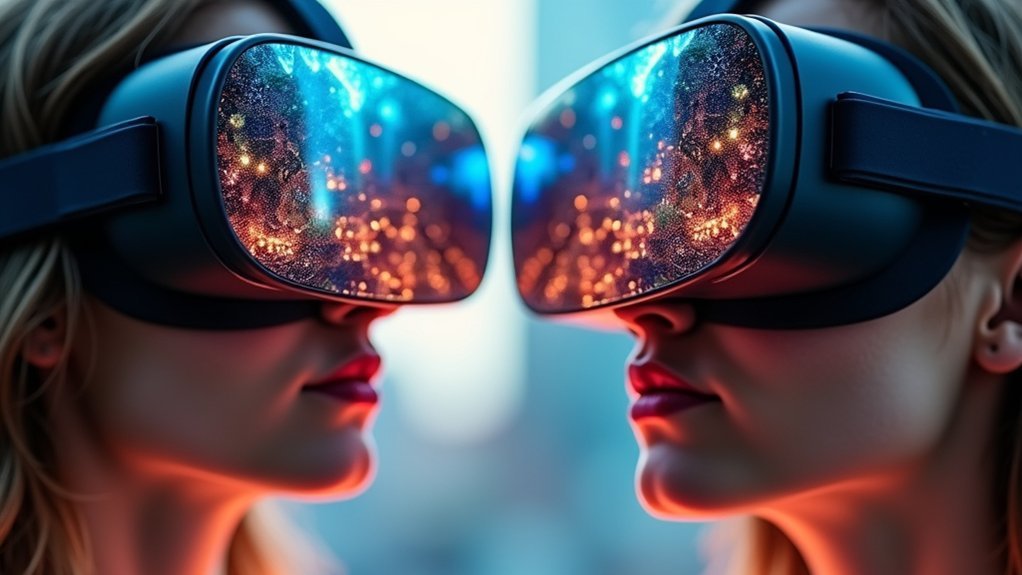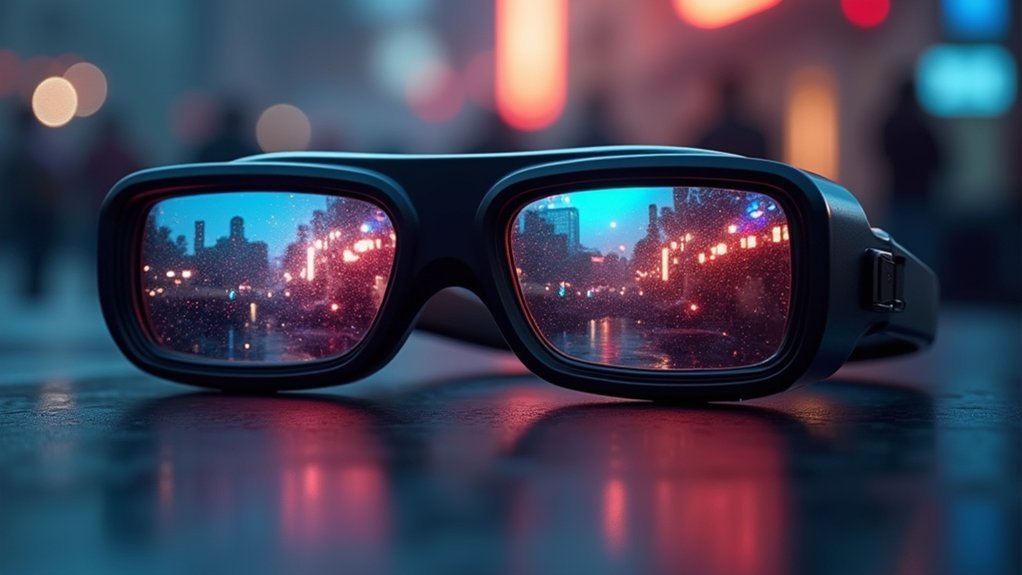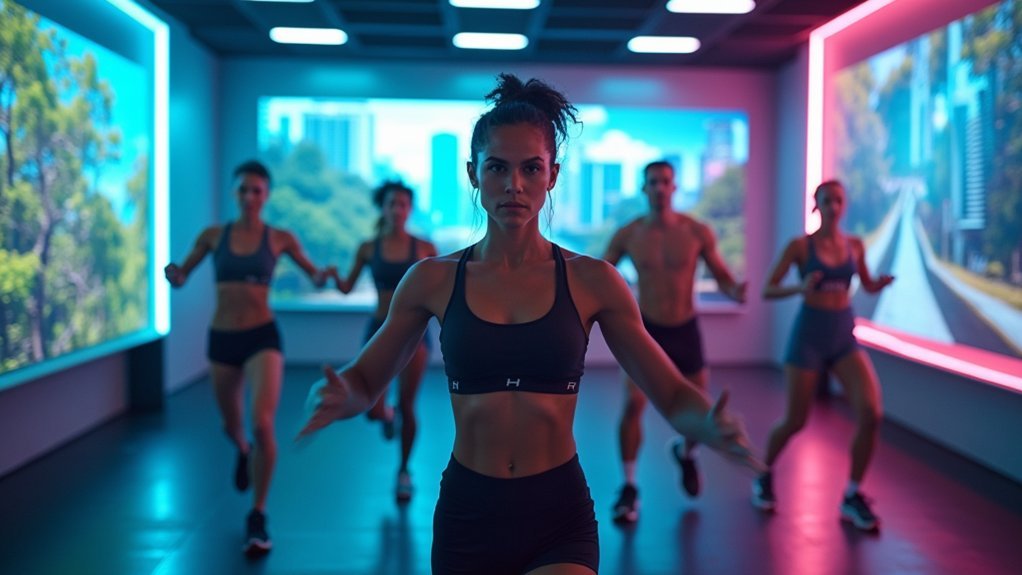VR binocular overlap greatly impacts your immersion by determining how well your brain merges left and right eye images into convincing 3D depth. When headsets achieve proper 120° overlap, you’ll experience enhanced spatial presence and realistic depth perception. However, insufficient overlap triggers binocular rivalry, causing eye strain and flat visuals that break immersion. Modern headsets like Quest 2 prioritize comfort through better overlap quality, while Quest 3 trades some overlap for wider field of view. Understanding these technical factors will help you optimize your virtual experience.
Understanding Binocular Overlap in Virtual Reality Systems

When you put on a VR headset, binocular overlap creates the foundation for convincing 3D vision by ensuring both your eyes see a shared visual field simultaneously. This overlap determines how well you’ll perceive depth and experience immersion in virtual reality (VR) environments.
Your headset’s design directly impacts the degree of binocular overlap you experience. While standard VR systems typically offer a 60-degree diagonal field of view (FOV), ideal overlap around 120° matches your natural human vision. This alignment enhances depth perception and reduces visual discomfort during extended use.
Your headset’s design determines binocular overlap quality, with ideal 120° alignment matching natural human vision for enhanced depth perception and reduced eye strain.
Insufficient overlap compromises your spatial presence and can cause eye strain or fatigue. Different headsets balance wider FOV against greater overlap differently, affecting your overall experience.
Understanding this relationship helps you choose systems that prioritize visual comfort and realistic depth estimation.
The Science Behind Depth Perception and Stereoscopic Vision
Behind every convincing VR experience lies your brain’s remarkable ability to process two slightly different images and transform them into coherent three-dimensional perception. Your stereoscopic vision works by calculating distances based on eye convergence angles, creating the depth perception that makes virtual worlds feel real.
VR headsets replicate this natural process by rendering separate perspectives for each eye. Your brain then merges these images, generating the immersive experience you feel in virtual environments.
| Factor | Impact on Depth Perception |
|---|---|
| Binocular Overlap | Determines 3D perception quality |
| Interpupillary Distance | Affects stereo image alignment |
| Lens Design | Influences optical clarity |
When VR headsets properly account for your unique interpupillary distance and maintain adequate binocular overlap, they create convincing depth cues that enhance immersion and reduce visual discomfort.
How VR Headsets Create Overlapping Visual Fields

Inside your VR headset, two separate displays work in tandem to create the overlapping visual fields that make virtual worlds feel three-dimensional. Each display renders slightly different images for your left and right eyes, mimicking how your brain naturally processes stereoscopic vision.
Your headset’s interpupillary distance setting adjusts the lens spacing to match your eye placement, optimizing this essential overlap.
The overlap is strongest at your visual field’s center, gradually decreasing toward the edges. This design directly impacts your depth perception and overall immersion quality.
The headset’s optical components—including lens type and display panel size—determine how effectively these overlapping regions merge. When properly calibrated, this sophisticated system creates convincing 3D experiences while reducing eyestrain during extended VR sessions.
Field of View Trade-offs in Modern VR Devices
While wider fields of view promise greater immersion, VR manufacturers face a fundamental engineering challenge: expanding your visual range often comes at the cost of binocular overlap quality.
Modern headsets typically offer 90-110 degrees field of view, balancing immersion with comfortable depth perception. You’ll find that 100% binocular overlap guarantees consistent 3D experiences, while partial overlap (around 75%) can increase horizontal FOV but may cause eye strain and binocular rivalry.
This trade-off considerably impacts your VR experience. Companies like Pimax have pushed boundaries with 200-degree diagonal FOV while maintaining stereo overlap, but most manufacturers must choose: maximize immersion through wider viewing angles or prioritize visual comfort through better binocular overlap and enhanced depth perception.
Complete vs. Partial Overlap Design Strategies

VR manufacturers approach binocular overlap through two distinct design philosophies that fundamentally shape your visual experience.
Complete overlap guarantees your eyes’ visual fields align perfectly, creating consistent 3D experiences with enhanced depth perception. You’ll experience reduced visual discomfort and strain, making extended sessions more comfortable. However, you’re trading field of view for stability—typically limiting you to 60 degrees diagonal FOV.
Complete overlap sacrifices field of view for visual comfort, delivering perfect eye alignment and reduced strain during extended VR sessions.
Partial overlap expands your peripheral vision, potentially reaching 70 degrees with 60-degree eyepieces, boosting immersion levels considerably. You’ll gain broader visual awareness, but you might encounter binocular rivalry and image discontinuity where the fields don’t align. This creates processing challenges for your brain, potentially causing fatigue.
Most users prefer complete overlap’s comfort over partial overlap’s expanded view, which explains why manufacturers like Meta prioritize visual consistency in their latest headsets.
User Experience Variations Across Different Headset Models
You’ll notice striking differences in binocular overlap quality when comparing headset models, with the Quest 3’s improved clarity often coming at the cost of reduced overlap effectiveness.
Many users report preferring the Quest 2’s more consistent overlap despite its lower resolution, as it provides better comfort and fewer visual artifacts like ghosting or black edges.
These performance variations become particularly apparent when you’re gaming across different genres, where vertical action sequences can amplify overlap-related comfort issues depending on your headset choice.
Quest 3 Overlap Issues
Since Meta released the Quest 3, users have reported troubling binocular overlap issues that greatly impact their VR experience.
If you have a lower interpupillary distance (IPD), you’ll likely experience significant discomfort and reduced visual comfort. The Quest 3’s design prioritizes increased field of view (FOV) over proper binocular overlap, resulting in severe ghosting and distracting black edges that diminish immersion.
You’ll notice the Quest 3 offers improved clarity compared to the Quest 2, but this enhancement comes at a steep cost. The reduced overlap creates visual inconsistencies that many users find jarring.
Community feedback consistently shows disappointment with these hardware design flaws, with many preferring the Quest 2’s more reliable overlap despite its smaller FOV.
Cross-Model Performance Comparisons
When comparing user experiences across different VR headset models, the Quest 3’s trade-offs become starkly apparent against its predecessors.
You’ll notice the Quest 2 delivers more consistent binocular overlap, creating superior immersion for users with lower interpupillary distance (IPD) measurements. While the Quest 3 expands your field of view (FOV), this enhancement comes at a cost—reduced overlap that triggers eyestrain and visual discomfort.
The head-mounted display (HMD) design differences create distinct user preferences. Quest 2 users report fewer ghosting issues and black edges, maintaining comfortable virtual reality experiences.
However, Quest 3’s diagonal screen positioning at 21° does improve mid-elevation overlap. Your individual IPD rating becomes the determining factor in which model provides ideal immersion, highlighting how binocular overlap design greatly impacts your overall VR experience quality.
Technical Challenges With Meta Quest 3 Overlap Issues
Although Meta’s Quest 3 represents a significant advancement in VR technology, it’s plagued by several technical challenges that directly impact binocular overlap performance. The headset’s 21° diagonal screen positioning creates uneven overlap distribution across your visual field, while users with lower IPD experience significant eyestrain. These hardware design flaws manifest as severe ghosting and distracting black edges that break immersion.
| Issue | Impact | User Reports |
|---|---|---|
| 21° Screen Angle | Inconsistent overlap | Mid-elevation improvements only |
| Low IPD Support | Poor visual comfort | Significant eyestrain complaints |
| Ghosting/Black Edges | Reduced immersion | Widespread disappointment |
| FOV vs Overlap Trade-off | Compromised experience | Quest 2 preference expressed |
You’ll notice Meta prioritized expanded field of view over consistent binocular overlap, requiring future lens adjustments and redesigns to satisfy your eyes’ comfort needs.
Visual Comfort and Eye Strain Considerations
These technical limitations directly affect how your eyes process VR content, creating a cascade of visual comfort issues that extend far beyond simple hardware inconvenience.
When your head-mounted display (HMD) lacks sufficient binocular overlap, you’ll experience conflicting images that force your visual system into overdrive. This binocular rivalry triggers immediate eye strain as your brain struggles to reconcile mismatched inputs from each eye.
You’ll notice fatigue setting in faster during extended sessions, particularly if you have a lower interpupillary distance. The reduced visual comfort directly undermines immersion since your cognitive resources shift from enjoying content to managing visual discomfort.
Poor binocular overlap also compromises depth perception, making spatial relationships unclear and forcing your eyes to work harder to maintain focus throughout your VR experience.
Impact on Spatial Presence and Realism
Because your brain relies on binocular overlap to construct convincing three-dimensional worlds, inadequate overlap in VR headsets directly undermines your sense of spatial presence.
Insufficient binocular overlap in VR headsets disrupts your brain’s natural depth processing, breaking the illusion of immersive three-dimensional environments.
When binocular overlap falls short of the ideal 120°, you’ll experience diminished realism and reduced immersion in virtual environments.
The relationship between overlap and spatial presence manifests in several key ways:
- Enhanced depth perception – Proper overlap allows accurate distance judgment and object positioning
- Reduced visual discomfort – Adequate overlap prevents eye strain and disorientation
- Improved environmental awareness – You’ll navigate virtual spaces more naturally and confidently
- Stronger presence sensation – Higher overlap correlates with feeling genuinely “inside” the virtual world
VR manufacturers who balance field of view (FOV) with sufficient binocular overlap create more convincing experiences, enabling you to achieve deeper immersion levels.
Hardware Design Factors Affecting Overlap Quality
When you’re examining VR headsets, you’ll find that lens positioning and angles fundamentally determine how your eyes perceive overlapping visual fields.
Your headset’s display panel configuration directly affects the quality of stereo overlap, with factors like screen size and diagonal positioning influencing depth perception.
The IPD adjustment mechanisms in your device must accommodate your unique eye spacing to guarantee ideal binocular fusion and visual comfort.
Lens Positioning and Angles
As you examine the internal architecture of modern VR headsets, you’ll discover that lens positioning serves as the foundation for quality binocular overlap. The Quest 3’s 21° diagonal angle creates enhanced overlap at mid-elevation, directly impacting your immersion through improved depth perception.
Your headset’s optical design determines how effectively these angled lenses work together:
- IPD adjustment range guarantees proper alignment between your eyes and the lenses
- Fresnel versus aspheric lens types affect overlap quality and field of view clarity
- Lens size and placement balance maximum FOV with ideal stereo overlap
- Diagonal positioning provides superior binocular overlap compared to traditional straight orientations
When lens positioning aligns correctly with your interpupillary distance, you’ll experience seamless depth perception that makes virtual environments feel convincingly real.
Display Panel Configuration
The display panels themselves form the visual foundation that determines how effectively your headset can create convincing binocular overlap. Larger panels provide a wider field of view for each eye while maintaining essential overlap for depth perception.
The optical design choices—whether manufacturers use Fresnel or aspheric lenses—significantly affect how light transmits to your eyes, directly impacting stereo overlap clarity.
Your interpupillary distance adjustment becomes vital here, as mismatched settings reduce effective binocular overlap and cause visual discomfort that destroys your immersive experience.
Panel positioning angles, like the Quest 3’s 21° diagonal configuration, can enhance overlap at mid-elevation but limit uniformity across your entire visual field. This creates the fundamental trade-off between maximum field of view and best overlap quality.
IPD Adjustment Mechanisms
Since your eyes naturally sit at different distances apart than other users’, VR headsets must provide precise IPD adjustment mechanisms to align the optical centers with your pupils.
Modern headsets like the Meta Quest 3 typically offer adjustment ranges between 58mm and 72mm, ensuring proper binocular overlap for most users.
Effective IPD adjustment mechanisms deliver several critical benefits:
- Enhanced visual comfort through proper lens alignment with your pupils
- Reduced eye strain by eliminating the need for your eyes to compensate for misaligned optics
- Improved immersion via ideal stereo overlap and depth perception
- Better image clarity when optical configuration matches your interpupillary distance
Without adequate adjustment capabilities, you’ll experience significant discomfort and compromised immersion, particularly if your IPD falls outside the headset’s supported range.
Future Developments in VR Optical Engineering
Looking ahead, VR optical engineers are working to revolutionize how you’ll experience virtual worlds through groundbreaking advances in binocular overlap optimization.
They’re developing sophisticated lens technologies, including aspheric and Fresnel designs, that’ll maximize stereo overlap while preserving your field of view (FOV). You’ll benefit from enhanced visual comfort as manufacturers prioritize reducing eye strain through improved overlap configurations.
Future headsets will feature more precise adjustable interpupillary distance (IPD) mechanisms, accommodating diverse users seamlessly.
Precision IPD adjustment systems in next-generation VR headsets will deliver personalized comfort for users across all demographics.
The most exciting development involves adaptive optics integration, which’ll automatically adjust overlap based on your specific visual parameters in real-time. This technology promises unprecedented immersion levels by continuously optimizing your viewing experience as you move through virtual environments.
Frequently Asked Questions
What Is Overlap in VR?
Overlap in VR is the shared visual space both your eyes see simultaneously. It’s essential for creating convincing 3D effects and proper depth perception, making virtual environments feel more realistic and immersive.
How Is VR Not Bad for Your Eyes?
You won’t damage your eyes with proper VR use because effects like eyestrain are temporary and resolve quickly. You’ll stay comfortable by adjusting IPD settings correctly and taking regular breaks during sessions.
What Does Binocular Overlap Mean?
Binocular overlap means you’re seeing the same area with both eyes simultaneously. It’s when your left and right visual fields intersect, creating roughly 120° of shared vision that enables depth perception.
What Is the Difference Between Binocular Overlap and FOV?
You’ll find that FOV represents your total visible area through each eye, while binocular overlap specifically describes the shared central region where both eyes’ fields intersect for depth perception.





Leave a Reply